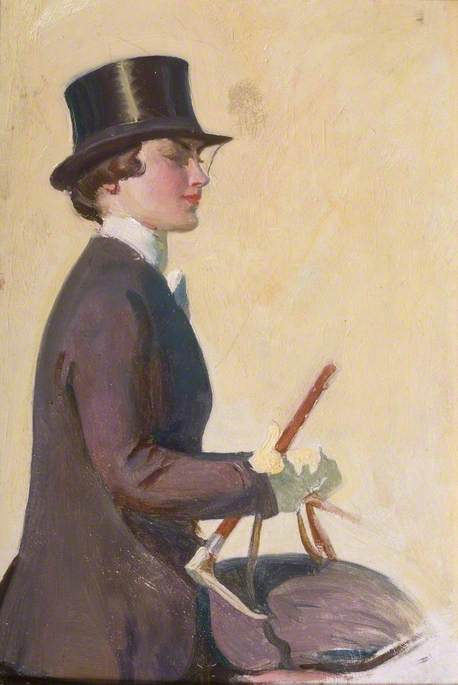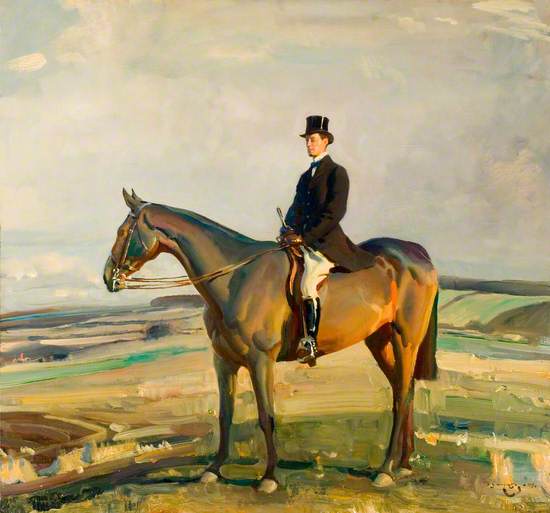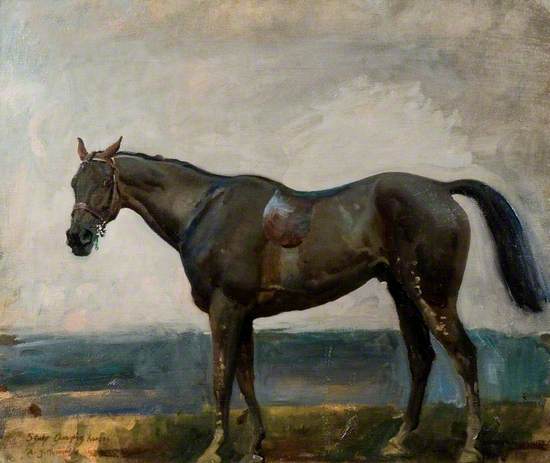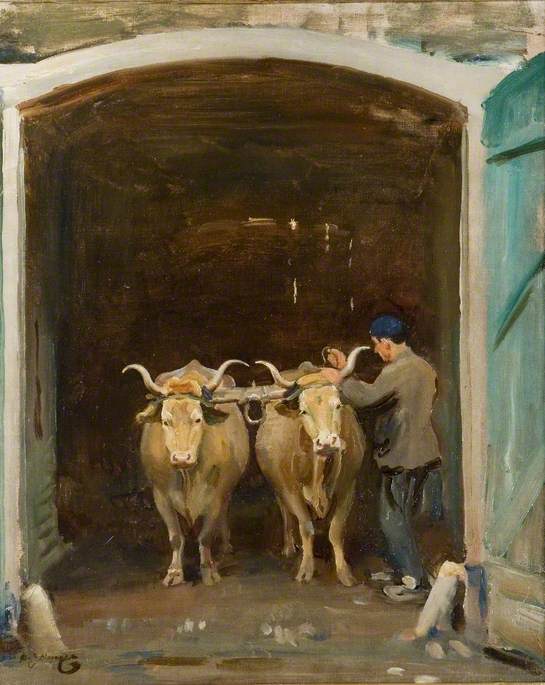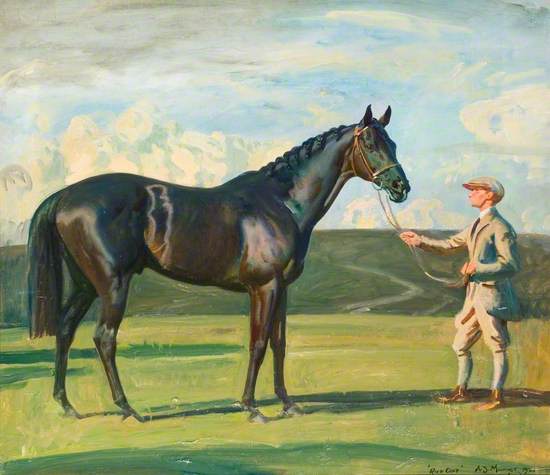The Munnings Art Museum special exhibition 2021: Yours with Love, AJ
When Alfred Munnings married his second wife Violet in April 1920 his reputation as a notable equestrian portraitist was flourishing. As a result of this he was frequently away from home for extended periods and he wrote home to his new wife of these experiences. The museum’s displays are interwoven with original correspondence, preparatory sketches and finished works that relate to this time.
To accompany the exhibition the museum has published a unique volume of the fifty of these hitherto unpublished and generally unseen personal letters written between 1920 and 1922.
Study of Lady Munnings for 'Our Mutual Friend the Horse'
Alfred James Munnings (1878–1959)
Oil on board
H 24 x W 16 cm
The Munnings Art Museum
My Wife, My Horse and Myself
This is a far more technical painting than it first seems. Munnings has used the architecture of the house to frame key aspects of the picture. Violet is directly in the middle of the composition, with perspectival depth emphasised by the angles of Munnings’ hat and palette. The colours blend and balance, with the blue of Munnings’ cravat replicated on his palette; the red of Violet’s lipstick on the saddle and curtain.
Alfred James Munnings (1878–1959)
Oil on canvas
H 101 x W 126.4 cm
The Munnings Art Museum
Lady Munnings Riding a Bay Hunter
This work may have been inspired by Changing Horses or have been a preparatory study for the work.
Alfred James Munnings (1878–1959)
Oil on canvas
H 88.9 x W 83.8 cm
The Munnings Art Museum
The White Canoe on the Stour at Flatford
A year after acquiring Castle House, Munnings married his second wife the renowned horsewoman Violet McBride in 1920. The high demand for his commissioned works forced him to spend considerable periods of time away. On one such occasion in May 1920 he wrote to Violet: “We’ll have evenings on the River when I get back. I’ll do a good one of you in the canoe. You see if I don’t...” On his return Munnings began a series of paintings. There have been at least 6 versions of the ‘The White Canoe’ with Violet and a friend.
Alfred James Munnings (1878–1959)
Oil on canvas
H 50.8 x W 60.3 cm
The Munnings Art Museum
Sir Raymond Greene, DSO, MP, on Horseback, 1919
Sir Raymond Green, DSO, MP on Horseback was one of Munnings’ first commissions after WWI; a direct result of the accolade he received for his equestrian war portraits at the Royal Academy Exhibition in early 1919. It was Sir Raymond Greene who arranged for Munnings to meet Major Tommy Bouch, Master of the Belvoir Hunt of which Munnings commented “…this was an introduction to a man who was offering more than I could ever have expected – board, lodgings, models without end..”.
Alfred James Munnings (1878–1959)
Oil on canvas
H 71.1 x W 76.2 cm
The Munnings Art Museum
Study for 'Changing Horses'
Alfred James Munnings (1878–1959)
Oil on canvas
H 50.8 x W 63 cm
The Munnings Art Museum
Oxen at an Archway Being Yoked, at Baron Robert's Estate, Chantilly
Munnings travelled to France in late 1921 to paint for Baron Robert de Rothschild at his Laversine Chateau near Chantilly. He had earlier painted the mares and foals at Southcourt Stud, near Leighton Buzzard, for another member of the Rothschild banking family, Anthony de Rothschild. As with various patrons he was invited to paint the family, the hunt and anything else of his choosing and welcome to stay for an extended period.
Alfred James Munnings (1878–1959)
Oil on canvas
H 65 x W 55 cm
The Munnings Art Museum
White Oxen, Baron Robert's Estate, Chantilly
While staying at Baron Robert de Rothschild's chateau, painting commissions, Munnings would venture out in order to paint local scenes for himself.
Munnings travelled to France in late 1921 to paint for Baron Robert de Rothschild at his Laversine Chateau near Chantilly. He had earlier painted the mares and foals at Southcourt Stud, near Leighton Buzzard, for another member of the Rothschild banking family, Anthony de Rothschild. As with various patrons he was invited to paint the family, the hunt and anything else of his choosing and welcome to stay for an extended period.
Alfred James Munnings (1878–1959)
Oil on canvas
H 35.6 x W 61 cm
The Munnings Art Museum
'Cherrybounce'
In his autobiography Munnings recalls naming a horse bred by him as Cherrybounce after a horse belonging to Lord Scamperdale in Mr Sponge’s Sporting Tour (1853), by R. S. Surtees. Munnings was inspired to write a ballad about Cherrybounce while out for a long ride with her on Exmoor and then resting at a deserted farmhouse. “Dreaming there; feeling the mellow warmth of the sun in my very bones, I gained fresh inspiration. The only paper in my pocket was was the small pad which I had already filled with my first flow of verses and alterations written on dismounting, by the stream.”
Alfred James Munnings (1878–1959)
Oil on board
H 19.7 x W 40.6 cm
The Munnings Art Museum
Study for 'Rich Gift'
This was the first thoroughbred horse Munnings painted at Castle House as a commission for Lady Torrington. Unlike Augereau, in the sandpit, Munnings has refined his use of colour and light. Rich Gift still maintains a sculptural effect but here Munnings brush strokes are smoother. The colours used on Rich Gift’s coat are not as obvious as those on Augereau. However, Munnings still uses greens, blues, pinks, yellows, browns and purple in order to create the form of the horse.
Alfred James Munnings (1878–1959)
Oil on canvas
H 66 x W 76.2 cm
The Munnings Art Museum
Study of Mrs Mark Stevens, 'Gipsy Life'
This small study of a woman was carried out in preparation for the larger painting, 'Gypsy Life', which is now in the collection of Aberdeen Art Gallery and Museums ,Scotland.
Alfred James Munnings (1878–1959)
Oil on panel
H 30.5 x W 40.6 cm
The Munnings Art Museum
Study of Isaac Bell
"The painting of Ikey Bell's portrait at his house in Kilkenny would fill pages were I to tell of all that happened and the people I met there,..."
'But', said Ikey, with a worried expression, 'If I have to sit on a wooden horse all dressed up in front of the house, what the deuce will people say when I come back to call?' I said 'Damn the callers; you just sit there!'
(Sir Alfred Munnings 'The Second Burst')
Alfred James Munnings (1878–1959)
Oil on board
H 24.1 x W 33 cm
The Munnings Art Museum
A Portrait Study of the Duchess of Westminster
The Duchess of Westminster was an exacting sitter for her portrait. In his autobiography Munnings recalls a visit to Eaton Hall in Cheshire, to paint her: ‘The Duchess in habit and bowler... The portrait of the Duchess was painted in the ball-room... The sitter, a well-built enough lady, would get down from the wooden saddle-horse and declare I was making her too stout. Again she sat on the saddle and again I altered the picture to her liking but not mine, for I thought her a perfect figure on a horse. “Look” said she, licking a soft pencil, “make my eyelashes darker...like this!” I should have painted the lady as I saw her...the picture of health-a good colour-a good figure-a strong seat on a horse; grace and beauty combined.’
Alfred James Munnings (1878–1959)
Oil on board
H 40.6 x W 30.5 cm
The Munnings Art Museum
.
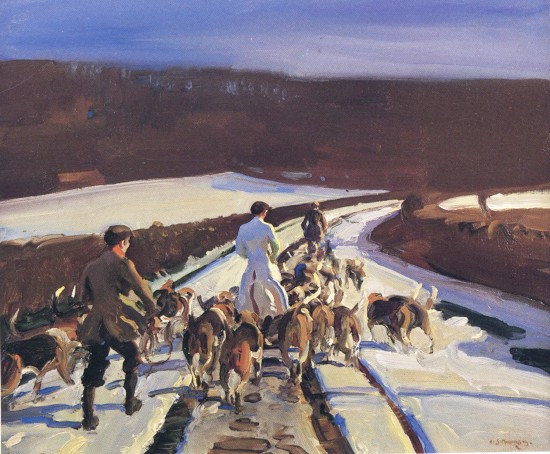
The Young Entry, a Snowy Road, Woolsthorpe
Following the exhibition the publisher Frost and Reed began to produce fine prints of the Belvoir Hunt scenes. The museum has several of these in its collection and this year is pleased to have on loan from a private collector three of the original paintings. Belvoir Hunt, Woolsthorpe, Grantham
Alfred James Munnings (1878–1959) Oil on canvas H 51cm x W 61cm Private collection
